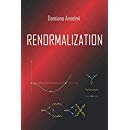We study the one-loop renormalization of high-energy Lorentz violating four fermion models. We derive general formulas and then consider a number of specific models. We study the conditions for asymptotic freedom and give a practical method to determine the asymptotic-freedom domain. We also point out that in some models the RG flow contains “rational” Zimmermann trajectories that might hide new symmetries.
Phys. Rev. D81 (2010) 085043 | DOI: 10.1103/PhysRevD.81.085043
We study a QED extension that is unitary, CPT invariant and super-renormalizable, but violates Lorentz symmetry at high energies, and contains higher-dimension operators (LVQED). Divergent diagrams are only one- and two-loop. We compute the one-loop renormalizations at high and low energies and analyse the relation between them. It emerges that the power-like divergences of the low-energy theory are multiplied by arbitrary constants, inherited by the high-energy theory, and therefore can be set to zero at no cost, bypassing the hierarchy problem.
Phys. Rev. D 81 (2010) 085042 | DOI: 10.1103/PhysRevD.81.085042
If Lorentz symmetry is violated at high energies, interactions that are usually non-renormalizable can become renormalizable by weighted power counting. Recently, a CPT invariant, Lorentz violating extension of the Standard Model containing two scalar-two fermion interactions (which can explain neutrino masses) and four fermion interactions (which can explain proton decay) was proposed. In this paper we consider a variant of this model, obtained suppressing the elementary scalar fields, and argue that it can reproduce the known low energy physics. In the Nambu$-$Jona-Lasinio spirit, we show, using a large $N_c$ expansion, that a dynamical symmetry breaking takes place. The effective potential has a Lorentz invariant minimum and the Lorentz violation does not reverberate down to low energies. The mechanism generates fermion masses, gauge-boson masses and scalar bound states, to be identified with composite Higgs bosons. Our approach is not plagued by the ambiguities of approaches based on non-renormalizable vertices. The low-energy effective action is uniquely determined and predicts relations among parameters of the Standard Model.
Eur.Phys.J. C65 (2010) 523-536 | DOI: 10.1140/epjc/s10052-009-1211-z
arXiv:0904.1849 [hep-ph]
We study the Standard-Model extensions that have the following features: they violate Lorentz invariance explicitly at high energies; they are unitary, local, polynomial and renormalizable by weighted power counting; they contain the vertex $(LH)^2$, which gives Majorana masses to the neutrinos after symmetry breaking, and possibly four fermion interactions; they do not contain right-handed neutrinos, nor other extra fields. We study the simplest CPT invariant Standard-Model extension of this type in detail and prove the cancellation of gauge anomalies. We investigate the low-energy recovery of Lorentz invariance and comment on other types of extensions.
Phys.Rev. D79 (2009) 025017 | DOI: 10.1103/PhysRevD.79.025017
arXiv:0808.3475 [hep-ph]
We classify the local, polynomial, unitary gauge theories that violate Lorentz symmetry explicitly at high energies and are renormalizable by weighted power counting. We study the structure of such theories and prove that renormalization does not generate higher time derivatives. We work out the conditions to renormalize vertices that are usually non-renormalizable, such as the two scalar-two fermion interactions and the four fermion interactions. A number of four dimensional examples are presented.
Annals Phys. 324 (2009) 1058-1077 | DOI: 10.1016/j.aop.2008.12.007
arXiv:0808.3474 [hep-th]
We construct local, unitary gauge theories that violate Lorentz symmetry explicitly at high energies and are renormalizable by weighted power counting. They contain higher space derivatives, which improve the behavior of propagators at large momenta, but no higher time derivatives. We show that the regularity of the gauge-field propagator privileges a particular spacetime breaking, the one into into space and time. We then concentrate on the simplest class of models, study four dimensional examples and discuss a number of issues that arise in our approach, such as the low-energy recovery of Lorentz invariance.
Annals Phys. 324 (2009) 874-896 | DOI: 10.1016/j.aop.2008.12.005
arXiv:0808.3470 [hep-th]
We study a class of Lorentz violating quantum field theories that contain higher space derivatives, but no higher time derivatives, and become renormalizable in the large N expansion. The fixed points of their renormalization-group flows provide examples of exactly “weighted scale invariant” theories, which are noticeable Lorentz violating generalizations of conformal field theories. We classify the scalar and fermion models that are causal, stable and unitary. Solutions exist also in four and higher dimensions, even and odd. In some explicit four dimensional examples, we compute the correlation functions to the leading order in 1/N and the critical exponents to the subleading order. We construct also RG flows interpolating between pairs of fixed points.
JHEP 0802 (2008) 051 | DOI: 10.1088/1126-6708/2008/02/051
arXiv:0801.1216 [hep-th]
We classify the unitary, renormalizable, Lorentz violating quantum field theories of interacting scalars and fermions, obtained improving the behavior of Feynman diagrams by means of higher space derivatives. Higher time derivatives are not generated by renormalization. Renormalizability is ensured by a “weighted power counting” criterion. The theories contain a dimensionful parameter, yet a set of models are classically invariant under a weighted scale transformation, which is anomalous at the quantum level. Formulas for the weighted trace anomaly are derived. The renormalization-group properties are studied.
Phys. Rev. D 76 (2007) 125011 | DOI: 10.1103/PhysRevD.76.125011
We consider higher-derivative perturbations of quantum gravity and quantum field theories in curved space and investigate tools to calculate counterterms and short-distance expansions of Feynman diagrams. In the case of single higher-derivative insertions we derive a closed formula that relates the perturbed one-loop counterterms to the unperturbed Schwinger-DeWitt coefficients. In the more general case, we classify the contributions to the short-distance expansion and outline a number of simplification methods. Certain difficulties of the common differential technique in the presence of higher-derivative perturbations are avoided by a systematic use of the Campbell-Baker-Hausdorff formula, which in some cases reduces the computational effort considerably.
J. High Energy Phys. 10 (2007) 099 | DOI: 10.1088/1126-6708/2007/10/099
We prove the renormalizability of various theories of classical gravity coupled with interacting quantum fields. The models contain vertices with dimensionality greater than four, a finite number of matter operators and a finite or reduced number of independent couplings. An interesting class of models is obtained from ordinary power-counting renormalizable theories, letting the couplings depend on the scalar curvature R of spacetime. The divergences are removed without introducing higher-derivative kinetic terms in the gravitational sector. The metric tensor has a non-trivial running, even if it is not quantized. The results are proved applying a certain map that converts classical instabilities, due to higher derivatives, into classical violations of causality, whose effects become observable at sufficiently high energies. We study acausal Einstein-Yang-Mills theory with an R-dependent gauge coupling in detail. We derive all-order formulas for the beta functions of the dimensionality-six gravitational vertices induced by renormalization. Such beta functions are related to the trace-anomaly coefficients of the matter subsector.
Class. Quant. Grav. 24 (2007) 1927 | DOI: 10.1088/0264-9381/24/8/003
arXiv: hep-th/0611131

 Quantum Gravity
Quantum Gravity 


